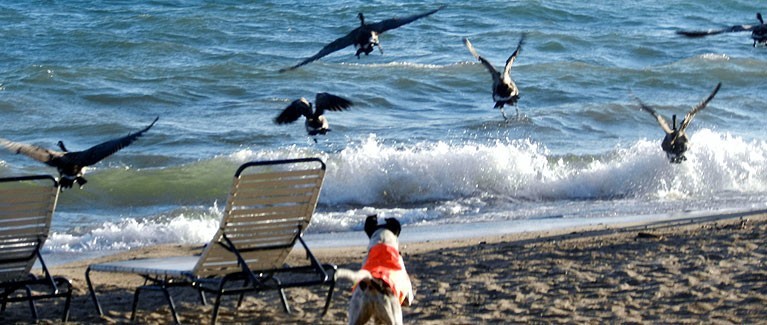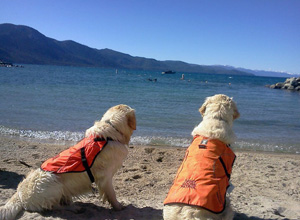Goose Patrol

Geese at the Beaches
Geese become a problem at our beaches when they feed on the turf, rest, stay overnight and leave their droppings. They prefer the beaches because they can see predators approaching and they have an escape route via the water. However, in the morning, their droppings leave a mess that can be equated to an overnight music concert with no trash barrels. In order to get the beaches ready for the day in Incline Village, the Parks Crew must perform an early morning clean up and attempt to make an effort to let the geese know they are not welcome.
In the past, it has been necessary to utilize the Nevada Division of Wildlife to conduct a geese roundup. Since the geese are unable to fly when they are molting, rounding them up during this time is the safest and easiest on the birds. Using wave runners, the geese are herded from the water onto the beaches and then into pens. In past years, Wildlife personnel have rounded up, tagged and relocated from 35 to 137 geese to an area outside the Tahoe basin. During the roundup the geese are also given a health check. This technique has only been moderately successful since approximately 30% of the birds return to our beaches.
Solution: Goose Patrol
The second method being implemented to control the geese is the use of eight dogs that have been recruited for the Goose Patrol by Parks Superintendent, Steven Phillips. Goose Patrol volunteers donate their time and efforts to rid the beaches of the geese. Dogs on the Goose Patrol wear red vests and owners have special identification authorizing them to be at the beaches. Arriving at a variety of times throughout the day, the dogs chase the geese back into the water. Because of their efforts, fewer geese come to the beaches or stay at the beaches. Cleanup from the geese droppings has been greatly reduced, hence saving labor and staff resources.
Geese Removal Program Methods and Procedures
Currently, the following approaches are being used to keep geese off the beaches and have been found to be the most effective:
- Use of volunteers on the Goose Patrol throughout the day with emphasis in the mornings, 6:00am to 11:30am, and during the evening two hours before dark until sundown.
- Limited use of noise makers to scare the geese off.
- Employees herding the geese back into the water.
- Laser gun infra-red beam to scare geese away.
- Signage requesting our customers help in not feeding the geese.
Basics of the Goose Patrol Program
- Volunteers and their dogs are interviewed and carefully selected for the program.
- Volunteers are educated in the multi-step program of geese removal.
- Volunteers are issued a red vest for their dogs with photo identification showing they are in the Goose Patrol Program. (NOTE: No additional volunteers are needed at this time.)
- Articles regarding the volunteers and their dogs have been printed in the local Bonanza newspaper to inform customers of the program.
- Volunteers are responsible and pick up after their dogs; this is a great trade off considering we were spending numerous resources to pick up after geese
- Fliers are posted at the three beaches showing pictures of the volunteers and their dogs
- The program and/or dogs are not intended to harm the geese, but simply encourage them to find another location to rest, eat and deposit their calling cards.
- The program is not 100% effective; there will still be geese sneaking onto the beaches and Parks Staff will make cleanup a high priority
- The program has been overwhelmingly received by our customers. Numerous customers have expressed their thanks for the ongoing efforts to control geese at the beaches
- The use of dogs to remove geese from various sites has reportedly been highly successful when used at other operations around the country
- Challenges for the geese removal program include insufficient Parks Staff or Goose Patrol Volunteers at the beaches at all times, and educating the Community about the efforts being made and approaches used to keep geese from the beaches
- The geese instinctively understand that dogs are natural predators and are alarmed simply at their presence
- The dogs used in this program vary in training but are all very friendly. Some of the dogs are trained to obey hand signals. Some are more of the family pet variety, and respond to voice commands. If you see a volunteer and their geese dog at the beach, don’t be surprised if you see them retrieving a ball. We’ve chosen dogs for their friendly outgoing behavior, ability to retrieve and follow directions. Be sure to thank the volunteers if you happen to see them at the beaches; they are providing a great service to the community.
If you have any questions, please contact Steven Phillips, Parks Superintendent at (775) 832-1228
Current Goose Patrol Volunteer Monthly Time Card Log